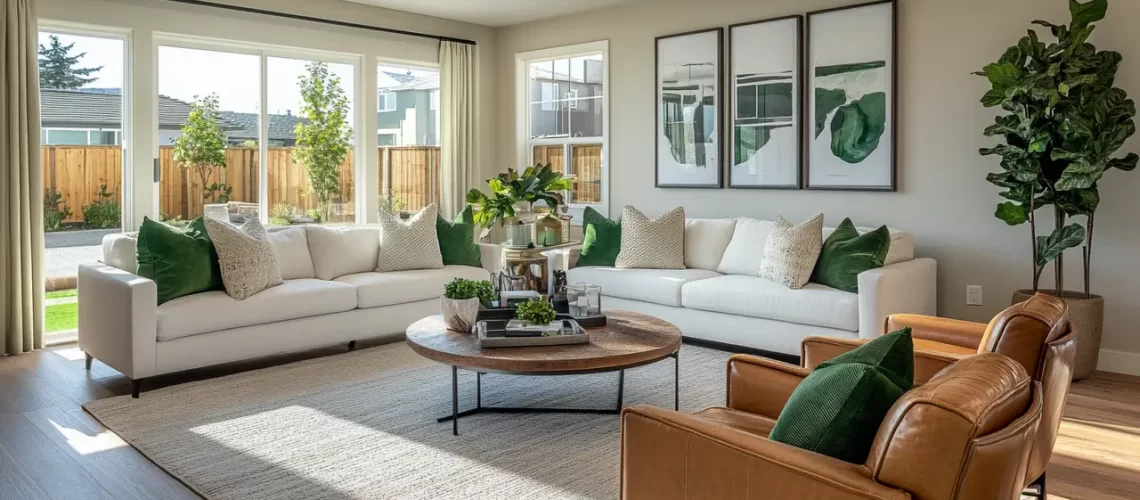Creating a luxurious home doesn’t have to break the bank. With some clever tricks and a bit of creativity, you can achieve an upscale interior design without spending a fortune. Let’s explore some essential tips to help you transform your space.
1. Focus on Key Investment Pieces
Begin by identifying pieces that define the room, such as sofas or dining tables, and invest in quality items that add character and durability to your space. Choosing the right investment pieces sets the tone for the entire room. Think of them as the foundation upon which your space is built. While these items might consume a significant portion of your budget, their impact on the room’s aesthetic and functionality cannot be overstated. High-quality pieces often age gracefully, blending durability with timeless style, ensuring they remain relevant through seasons of changing trends.
When selecting these key investment pieces, it’s also essential to consider their versatility. For instance, a sectional sofa can offer various configurations, adapting to changing space needs over time. Designer furniture often incorporates adaptable elements that ensure longevity and utility. By investing in pieces that serve multiple functions, you not only enhance the aesthetic value of your environment but also maximize the utility of every item in your space.
2. Shop Second-Hand for Unique Finds
Thrift stores and online marketplaces can be treasure troves of unique furniture and décor items that offer a touch of sophistication without the high price tags. The thrill of discovering second-hand pieces that echo a distinct retro charm or represent an unexpected artistic flair is unmatched. Vintage items often carry stories and histories that new pieces simply cannot replicate, offering your space a unique character.
Platforms like Facebook Marketplace and local flea markets allow you to explore a variety of styles and eras in one place. Whether you stumble upon an antique side table or a mid-century chair, these finds often require little refurbishment to become centerpieces in your home. With a coat of paint or new upholstery, second-hand treasures become restored jewels in your interior design project.
It’s also an opportunity to support sustainable living by giving new life to pre-loved items, reducing the demand for mass production. Embracing second-hand shopping not only helps your wallet but also plays a part in sustainable interior design.
3. Incorporate DIY Elements
Adding personal touches through DIY projects can infuse creativity and individuality into your home, all while keeping costs down. DIY projects allow you to tailor decor precisely to your liking—from creating custom photo frames to crafting a one-of-a-kind coffee table using repurposed wood. In Raleigh, NC, consider drawing inspiration from local design aesthetics while customizing projects that complement your space’s vibe.
The world of DIY is vast and can accommodate any skill level. Start with simple tasks like painting accent walls or upholstering old chairs with vibrant fabric. As your confidence grows, tackle more complex projects like building modular shelving units or creating abstract wall art. The internet offers countless DIY tutorials that provide step-by-step guidance, enabling even a novice to successfully undertake intricate endeavors.
4. Embrace Minimalism
A minimalist approach can help create a sleek and modern look. By prioritizing fewer, high-quality items, you can achieve a visually appealing balance. Minimalism also encourages thoughtful curation, selecting pieces that hold meaning or serve a dual purpose, reducing unnecessary clutter and placing a spotlight on the beauty of simplicity. It’s about creating an environment that reflects tranquility and organization, providing a sanctuary of calm amid the chaos of daily life.
Minimalism doesn’t equate to sacrificing style. On the contrary, it provides an opportunity to focus on quality, highlighting well-crafted pieces that stand out due to their design and material. Clean lines, neutral tones, and open spaces create an aura of sophistication without overwhelming the senses. If you want to begin with minimalist design in your living room, explore our guide on how to start with minimalist interior design in your living room.
5. Experiment with Texture and Patterns
Playing with different finishes and fabrics can add depth and interest to a room, making the space feel high-end on a budget. Think of mixing leather with linen or silk with wool to create unexpected but harmonious combinations. Experiment with contrasting textures, such as smooth and coarse surfaces, to design a dynamic and inviting environment.
Incorporating patterns adds another layer of complexity to your design. Whether it’s through textiles like rugs and pillows, or via the art on your walls, patterns can break up monotony and introduce focal points within your room. Consider using geometric patterns for a modern twist or floral motifs for a touch of whimsy. The key is to strike a balance that reflects your personal style, creating a space that’s both dynamic and cohesive.
6. Use Paint to Transform a Space
A fresh coat of paint, whether on walls or furniture, can dramatically alter the look and feel of a room, imparting an upscale vibe. Paint is one of the most cost-effective tools in your interior design arsenal, offering an instant means to refresh any space. The right color can set the mood, make a small room feel larger, or even add a cozy vibe to an expansive area.
When selecting colors, consider how they’ll interact with your furniture and decor. Neutrals provide a soothing backdrop, while bold hues can highlight architectural features or create a statement wall. If you’re unsure, explore resources like color psychology to guide your choices based on the room’s function. Additionally, don’t overlook the power of paint techniques such as color blocking or ombre, which can add a layer of sophistication without requiring significant investment.
7. Incorporate Greenery
Plants and botanical accents can add life and luxury to any space. Their natural beauty offers a refreshing contrast to hard surfaces. Not only do they contribute to a sense of tranquility, but plants also improve air quality, making them a healthy addition to your home. Whether you opt for low-maintenance succulents or lush tropicals, there’s a plant to suit every level of commitment and style.
Incorporate greenery through potted plants, hanging planters, or even a living wall, which serves as both decor and an art piece. Complementing plants with elegant pots can elevate the overall aesthetic. Pairing diverse types of plants can create a layered look, enhancing the room’s visual appeal while bringing in a slice of nature.
8. Upgrade Lighting Fixtures
Lighting plays a crucial role in setting the mood. Opt for chic fixtures that make a statement and complement your design scheme. Whether it is the elegance of a chandelier, the modern edge of a pendant, or the soft romance of a string of fairy lights, illumination affects how we perceive space and color. Thoughtfully placed lighting can enhance focal points or create ambient warmth, shaping the atmosphere of the room.
Combining various types of lighting—ambient, task, and accent—enables the modulation of atmosphere, supporting different activities and moods. Replacing outdated fixtures with contemporary designs can significantly elevate your room’s style quotient. Moreover, investing in energy-efficient lighting options, like LED bulbs, ensures sustainability and reduces utility costs, aligning with modern design priorities.
9. Mix High and Low End Decor
Combine affordable basics with a few standout pieces to create a balanced and curated look that exudes luxury. The interplay between high and low can infuse sophistication into your design approach, all while staying within budget. This method focuses on acquiring signature items, such as a designer lamp or a piece of abstract art, that draw attention and provide context for the less expensive, supportive decor.
Being selective about pricier items ensures that each piece makes a significant impact, enhancing the overall design narrative. Meanwhile, mixing with budget-friendly options like minimalist side tables or chic throws adds texture and layers without overwhelming the budget. Embrace this strategy to allow for adaptable and personalized spaces—proving that upscale style does not necessitate upscale spending.
10. Declutter for a Clean Look
Maintaining a clutter-free environment enhances the overall design, allowing the elegance of your thoughtfully chosen decor to take center stage. Decluttering not only emphasizes space but also brings clarity and focus, helping to highlight key design elements. It promotes orderliness, enhancing the room’s aesthetic impact and creating a serene retreat within your home.
Regularly assess the necessity of items, eliminating those that no longer serve a purpose or bring joy. By focusing on simplicity and functionality, decluttering becomes an ongoing process that supports both the physical and mental clarity of the space. As seen in chic home interiors, you can integrate smart storage solutions to maintain an organized area while preserving style. Proper organization prevents chaos from diminishing the upscale allure of your space, ensuring a lasting impression.


